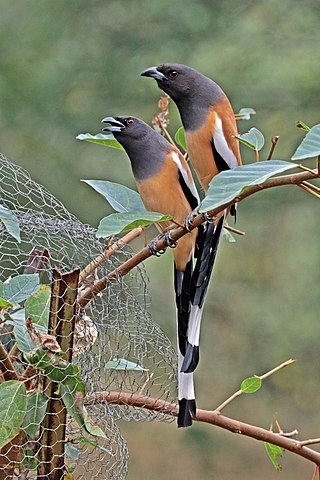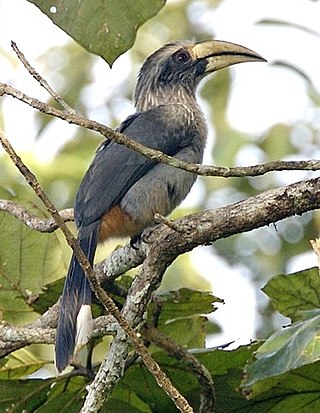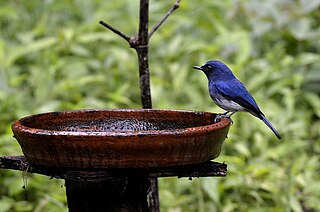
The rufous treepie is a treepie, native to the Indian Subcontinent and adjoining parts of Southeast Asia. It is a member of the crow family, Corvidae. It is long tailed and has loud musical calls making it very conspicuous. It is found commonly in open scrub, agricultural areas, forests as well as urban gardens. Like other corvids it is very adaptable, omnivorous and opportunistic in feeding.

Dendrocitta is a genus of long-tailed passerine birds in the crow and jay family, Corvidae. They are resident in tropical South and Southeast Asia. The generic name is derived from the Greek words dendron, meaning "tree," and kitta, meaning "magpie".

The collared treepie, also known as black-faced treepie or black-browed treepie, is an Asian treepie, a small perching bird of the crow family, Corvidae.

The grey treepie, also known as the Himalayan treepie, is an Asian treepie, a medium-sized and long-tailed member of the crow family. The species was first described by Robert Swinhoe in 1863. They are widely distributed along the foothills of the Himalayas in the Indian Subcontinent and extending into Indochina, southern mainland China and Taiwan. The populations vary in plumage and several are named as subspecies.

The rufous-bellied eagle or rufous-bellied hawk-eagle is a bird of prey in the family Accipitridae that is found in the forested regions of tropical Asia. Relatively small for eagles and contrastingly patterned like a falcon, this species was earlier placed in the genus Hieraaetus and sometimes also in the genus Aquila but thought to be distinctive enough to belong to a separate genus.

The Malabar gray hornbill is a hornbill endemic to the Western Ghats and associated hills of southern India. They have a large beak but lack the casque that is prominent in some other hornbill species. They are found mainly in dense forest and around rubber, arecanut or coffee plantations. They move around in pairs or small groups, feeding on figs and other forest fruits. Their loud cackling and laughing call makes them familiar to people living in the region.

The tawny-bellied babbler also known in older Indian works as the rufous-bellied babbler is a small babbler that forages in small groups in low scrub forests. Like other members of the large Old World babbler family they are passerine birds characterised by soft fluffy plumage. There are three subspecies within the Indian Subcontinent. The nominate hyperythra found in northern and eastern India is uniformly brown underneath while albogularis of the western Indian peninsula is white throated. The population in Sri Lanka, phillipsi, is also white throated but is paler underneath and has a larger bill.

The white-bellied blue flycatcher is a small passerine bird in the flycatcher family Muscicapidae. It is endemic to the Western Ghats of southwest India. Males are dark blue with a lighter shade of blue on the brow and have a greyish white belly. Females have a rufous breast, a white face and olive grey above.

The African paradise flycatcher is a medium-sized passerine bird. The two central tail feathers of the male are extended into streamers that commonly are more than twice as long as the body. The female tail feathers are of moderate length and without streamers. The upper parts of the male body, wings, and tail are boldly coloured in chestnut or rusty shades, but the underparts and the head are variably grey to blue-gray, with the head of the mature male being darker, commonly glossy black with greenish highlights. The beak and other bare areas, including a wattle ring round the eye, match the colour of the surrounding feathers. The female coloration is similar, though not so showy and glossy and with the head paler.

Netravali Wildlife Sanctuary is located in South-Eastern Goa, India. It constitutes one of the vital corridors of the Western Ghats and covers an area of about 211km2. Netravali or Neturli is an important tributary of River Zuari, which originates in the sanctuary. Forests mostly consist of moist deciduous vegetation interspersed with evergreen and semi-evergreen habitat; there are also two all-season waterfalls in the sanctuary.

The rufous babbler is an endemic species of bird found in the Western Ghats of southern India of the family Leiothrichidae It is dark brown and long tailed, and is usually seen foraging in noisy groups along open hillsides with a mixture of grass, bracken and forest.

The Bornean treepie is a passerine bird belonging to the treepies genus, Dendrocitta, of in the crow family, Corvidae. It is endemic to the island of Borneo. It is sometimes treated as a subspecies of the Sumatran treepie.

New Amarambalam reserved forest is a reserved forest in the Western Ghats, situated in the Malappuram District of Kerala state of India. It extends till Silent Valley National Park of the Palakkad District to the south and to Nadugani in the Nilgiri District of Tamil Nadu to the North. It is under the Karimpuzha Wildlife Sanctuary.



















